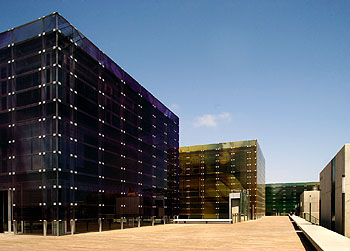

Ciudad Politécnica de la Innovación. Valencia
Polytechnic City of Innovation. Valencia
Luís Manuel Ferrer Obanos
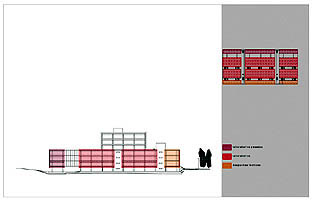
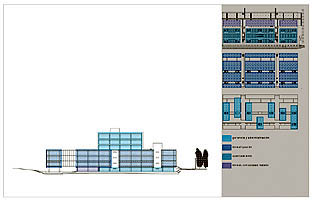
 |
|
||
|
Ciudad Politécnica de la Innovación. Valencia Polytechnic City of Innovation. Valencia |
Arquitecto/Architect: Luís Manuel Ferrer Obanos |
 |
 |
|
|
|||
| Son varias
las variables con las que trabajamos a la hora de generar una idea: color,
forma, flujos, función, clima, luz... los binomios lleno-vacio,
pesado-ligero..., entendiendo que todas ellas se interrelacionan sin orden
ni ajuste, sino en un continuo ir y venir. En nuestra mano queda darle mas
o menos importancia a una o a otra, sobre todo a la hora de querer
transmitir una idea.
En el año 2000 la U.P.V. convoca un concurso de ideas para la realización de la ciudad politécnica de la innovación I. Se trata de un edificio que pretende alojar institutos de investigación de muy diferentes necesidades hasta cubrir una superficie construida de 72.000 m2. Este concurso presento tres aspectos destacables: la situación, la necesidad de ejecutarse en tres fases independientes y la ausencia de programa pormenorizado en cada uno de los institutos. |
We work with various variables when we are generating an idea: colour, form, flows, function, the climate, the light, the poles of full/empty, heavy/light, etc. They all interact in no particular order or arrangement, coming and going continuously. It is up to us to decide the relative importance of one or another, particularly when we want to convey an idea. In the year 2000 the Polytechnic University of Valencia convened an ideas competition for the Polytechnic City of Innovation I. This is a building to house research institutes with very different requirements up to a total gross floor area of 72,000 m2. The competition presented three notable aspects: the location, the need to build in three separate stages and the lack of a detailed brief for each of the research institutes. |
|
Situación/Location: Universidad Politécnica de Valencia, Camino de Vera, s/n. Valencia/Polytechnic University of Valencia, Camino Vera s/n, Valencia Promotor/Developer: Colaboradores/Collaborators: Empresa constructora/Contractor: Fotógrafo/Photographer: |
| Se
pretende inventar un sistema general que nos de cabida a muy diversos
programas particulares inicialmente desconocidos. Proponemos 5 conceptos básicos
para lograr estas intenciones: Estratificación vertical, estratificación
horizontal, flujos de circulación, maclas espaciales y por supuesto los
sistemas de control de iluminación natural.
Estratificación vertical la cual interviene en el aspecto formal del edificio, localizando una planta semisótano semiabierta para alojar institutos donde sea imprescindible el acceso rodado y laboratorios pesados, un zócalo de tres plantas dedicado a la investigación y unos cubos acristalados de una dos o tres plantas donde establecemos la gerencia y la administración. Estratificación horizontal, ésta a diferencia de la anterior se localiza fundamentalmente en el zócalo. Dividiéndonos el zócalo en tres grandes zonas: laboratorios pesados, laboratorios comunes, y despachos técnicos. Conceptualmente aprovechamos esta estratificación para introducir, de forma sutil, la luz a la zona principal de investigación, entendiendo que además del control térmico la idea de los patios inducen a la concentración. |
Following this introduction, we can move on to commenting on the project as an idea and as a result, although this will not be known definitively until the third stage has been built in late 2007. The idea is to invent a general system that can accommodate very different individual briefs which are initially unknown. The system has to allow research institutes with very different needs (heavy, light, agricultural, computer, industrial etc. laboratories) to be lodged in the building, allow each of their particular briefs the greatest possible degree of independence while remaining a single building with shared facilities and allow each of these briefs the flexibility to change in the course of time. We finally proposed 5 basic concepts to achieve these intentions: Vertical stratification, horizontal stratification, circulation flows, spatial overlaps and, of course, natural light regulation systems. The vertical stratification influences the formal appearance of the building: a semi-open semi-basement to accommodate institutes that require vehicular access and heavy laboratory satellites of institutes located in other parts of the building, a three-storey plinth for research and one-, two- or three-storey glazed cubes for the management and administration. The horizontal stratification, unlike the vertical one, is mainly located in the plinth and has practically no influence on the formal aspects. It divides the plinth into three main zones: heavy laboratories, shared laboratories and technical offices. Conceptually, we took advantage of this stratification to introduce light subtly into the main research area, believing that the idea of courtyards not only helps to regulate the temperature but also induces concentration. |
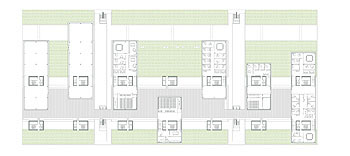
|
|
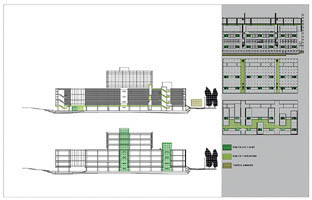 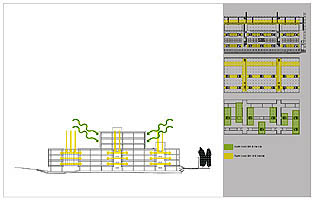 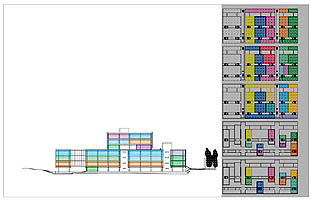 |
|||
| Flujos de circulación, divididos en tres tipos: Bus de personal que directamente del aparcamiento permite acceder al personal a cualquier planta. Bus de visitantes, el cual siempre desde zonas comunes, patios, calles transversales y longitudinales siempre sin climatizar y a través de escaleras y ascensores panorámicos accede directamente a la planta tercera desde donde se podrá recorrer verticalmente cualquier instituto sin interferir con otro. Sin duda la idea de los espacios no climatizados, patios, circulaciones, común en todos nuestros proyectos es la aportación del clima mediterráneo a nuestra idea de arquitectura, proponiendo en este caso un hall para pasear que a la vez no consume edificabilidad. Finalmente el flujo de tráfico pesado el cual localiza una calle rodada paralela a la localización de los laboratorios pesados donde se disponen longitudinalmente muelles de carga y descarga. |
Circulation flows we see as what makes everything else possible. We divided them into three types of flow: Personnel bus, enabling the staff to go directly from the car park to any of the floors, whether technical or administrative. Visitor bus from common areas, courtyards and transverse and longitudinal streets, always without climate conditioning, using stairs and panoramic lifts that go directly to the third floor (management and administration) from which any of the institutes can be reached vertically without passing through any other. No doubt the idea of spaces (courtyards and circulation areas) without climate conditioning, which all our projects share, is the contribution of the Mediterranean climate to our idea of architecture. In this case there is a hall in which to walk that does not eat into the permitted surface area. Finally, the heavy traffic flow is located in a vehicle road parallel to the position of the heavy laboratories, with loading and unloading bays placed along its length. |
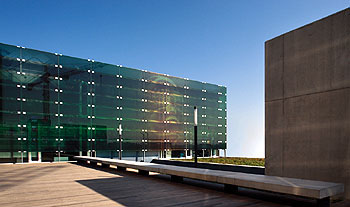
|
|
|
|
|||
| Maclas
espaciales, como infinitos posibles resultados de la mezcla de los tres
conceptos anteriores y donde las dos intenciones iniciales son exitosas.
Sistemas de iluminación natural, proponiendo luz indirecta a través de patios en la zona principal de investigación, y luz directa en la zona de administración y gerencia. El control de soleamiento donde en el zócalo se trata de forma natural con masa boscosa, mientras que en los cubos se consigue con un tratamiento continuo de una doble piel en la fachada donde la interior consigue la impermeabilidad a la vez que el aislamiento acústico y la exterior con vidrio serigrafiado consigue el control térmico. En ambos casos la idea de continuidad sea la orientación que sea nos da la posibilidad de cambio en el tiempo que incluso puedan afectar a fachada. Otros aspectos reseñables en la idea proyectual con la que decidimos trabajar son la forma, texturas y colores...El artificio con intención de generar naturaleza donde no la hay. Un lleno único y definido, aligerado por vacíos longitudinales y transversales + un vacío definido por los limites del propio lleno, colonizado por otros llenos como sin orden aparente.
|
Spatial overlaps are the infinite possible results of combining the above three concepts when the two initial intentions are successful. Natural lighting systems bring the light indirectly, through courtyards, into the main research area, which is understood as one that induces concentration, and directly into the administration and management area, as this is understood to be an area that should be more related to the exterior. Sunlight regulation is treated in a natural way in the plinth, which is screened by trees, while the cubes are protected by a continuous double skin over the façade: the inner skin provides weather-tightness and acoustic insulation while the outer skin of silk-screened glass achieves thermal control. In both cases the idea of continuity in every direction allows the possibility of changes in time, which may even affect the façade. Other features of the project idea we decided to work on were the shape, textures and colours, as well as using existing technologies; these aspects also help the user to interpret the system. The upper curtain wall, double, has protection from direct light on the exterior and flexible distribution in the interior which, in turn, is treated in dark tones to enhance the toning down of the light. The lower curtain wall, protected in concept, has indirect light, with interiors in light tones to favour and enhance the intensity of the light. The shape is the final result of all the above, wood solves the contact with the earth and silk-screened glass solves the nexus with the sky. Artifice is intended to generate nature where there is none. A single, clearly-defined solid lightened by longitudinal and transverse voids + a void defined by the limits of the solid, colonised by other solids as though in no apparent order.
|
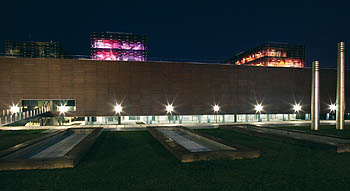
|
|
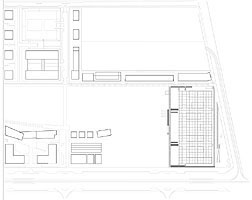 |
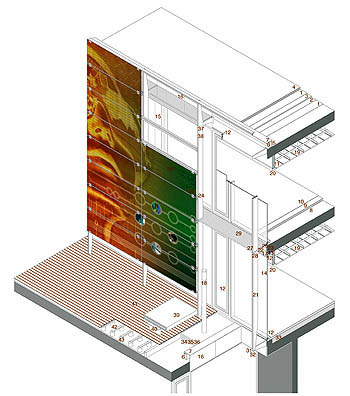 |
|
| 1. Fieltro geotextil/Geotextile felt 2. Impermeabilizante e=1.2 mm/Waterproofing t=1.2 mm 3. Aislamiento poliestileno extruido e=4 cm/Insulation, extruded polystyrene t=4cm 4. Gravas de árido máchale del 20/Máchale stone chippings, size 20 5. Remate chapolan en ángulo fijado mecánicamente/Edging, Chapolan, mechanical fixing 6. Bloque hormigón 20x40x8 cm/Concrete block, 20x40x8 cm 7. Remate chapa aluminio anodizado natural e=1.5 mm/Coping, anodised aluminium, natural colour, t=1.5 mm 8. Forjado reticular de Hormigón armado/Waffle slab, reinforced concrete 9. Recrecido de H.A./Screed, RC 10. Pavimento vinílico e=2 mm/Vinyl flooring t=2mm. 11. Barrera fónica compuesta por: plancha de naturvexe=8 mm, perfilería de acero galvanizado de 80 mm con lana de roca, plancha de cartón-yeso e=15 mm/Acoustic barrier: Naturvex panel t=8 mm, 80 mm galvanised steel section with rock wool, plasterboard t=15 mm 12. Carpintería de aluminio anodizado plata mate Technal/Joinery, Technal, matt silver-coloured anodised aluminium 13. Enfoscado/Rough render 14. Vidrio 8+8/8+8 glazing 15. Pilar metálico HEB-280/Metal pillar, HEB-280 16. Panel MAX exterior 2.4x1.2/Exterior panel, Max, 2.4x1.2 17. Perfilería tubular de 20x20x2 mm de acero galvanizado/Hollow section, galvanised steel, 20x20x2 mm 18. Luminaria/Lamp 19. Bandeja de aluminio microperforada/Grid, microperforated aluminium 20. Remate perimetral chapa lisa plegada e=1.5 mm/Edging, smooth folded sheet metal, t=1.5 mm 21. Doble pletina vertical 200x15 mm aluminio plata mate/Mullion, double plate, matt silver-coloured aluminium, 200x15 mm 22. Cartela e=20 mm y long=576 mm/Bracket t=20 mm l=576 mm 23. Chapa anclaje 225x150x10 de acero inox. esmerilado/Anchoring plate, frosted stainless steel, 225x150x10 24. Perfilería sujeción vidrio en aluminio plata mate/Fixing brackets, matt silver-coloured aluminium 25. Perfil acero inox. long=100 mm/Transom, stainless steel, l=100 mm 26. L50.5 de acero inoxidable esmerilado/L 50x5, frosted stainless steel 27. L40.5 de acero inox. esmerilado/L 40x5, frosted stainless steel 28. Tornillos inox. M12 + tuercas ciegas + casquillo tubo inox. 16x15/M12 stainless steel bolts + cap nuts + stainless steel collar 16x15 29. Religa de acero galvanizado 40x40/40x3 mm/Grating, galvanised steel, 40x40/40x3 mm 30. Vidrio segurit serigrafiado e=10 mm/Silk-screen printed tempered glass, t=10 mm 31. Rótula pletina e=20 mm en acero inox./Joint, plate t=20mm, stainless steel 32. Tornillo inox. M16 + casquillo tubo 20x1,5 + tuercas ciegas autoblocantes/M16 stainless steel bolt + collar 20x1.5 + self-locking cap nuts 33. Recrecido hormigón celular/Screed, air-entrained concrete 34. Capa drenante/Drainage fill 35. Fieltro geotextil/Geotextile felt 36. Sustrato ecológico drenante/Environmentally-friendly drainage substrate 37. Tornillos inox. M12 + tuercas ciegas/M12 stainless steel bolts + cap nuts 38. Pletina aluminio 100x5 mm/Mullion, aluminium plate, 100x5 mm 39. Losa h. Armado de 15x100 cm/Slab, reinforced concrete, 15x100 cm 40. IPN 450/IPN 450 41. Pavimento de exteriores madera Sucupira/Exterior decking, wood, Sucupira 42. Rastrel de pino cuperizado/Batten, copper naphthenate treated pine wood 43. Soporte regulable en altura/Adjustable leg |
||